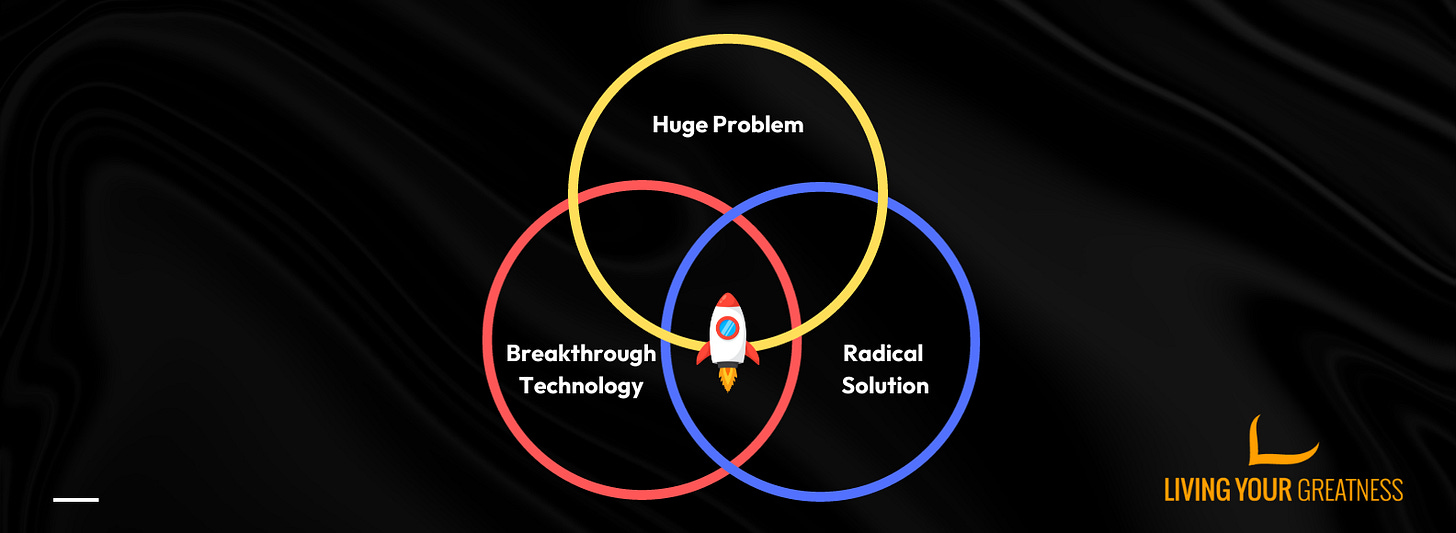Wisdom
One piece of wisdom that motivates, encourages and empowers you to grow.
“We choose to go to the moon. We choose to go to the moon in this decade and do other things, not because they are easy, but because they are hard.” -President John F. Kennedy
Insight
One insight that helps you deeply understand a situation, idea, or concept.
What is Moonshot Thinking?
Moonshot thinking is an innovative approach applicable to various fields, including business, where the aim is to set ambitious goals, at least 10x beyond the norm. This mindset shift inspires individuals and teams to tackle seemingly impossible challenges by framing them as solvable problems, using first principles of thinking and embracing fast-paced experimentation.
The Origin of Moonshot Thinking
Moonshot thinking, rooted in President John F. Kennedy's ambitious goal set seven years before the historic Apollo 11 mission in 1969, involves committing to seemingly impossible goals. Kennedy's declaration to reach the moon within a decade paved the way for this significant achievement, inspiring the nation to pursue an incredible feat despite uncertainties about the exact path or the challenges involved.
Astro Teller, the Director of X (formerly Google X), has embraced and transformed this moonshot concept into a mindset at Google's disruptive innovation division. X serves as a Moonshots factory, where projects leveraging cutting-edge technologies are conceived, tested, and launched to address the world's challenges with radical improvements.
In this mindset, tackling massive problems such as climate change involves proposing radical solutions through disruptive technologies. The emphasis is on moving away from small, incremental improvements (10%) and instead focusing on solutions that deliver tenfold (x10) improvements or even completely solve the problem.
The Secret Recipe for Moonshots
Anyone in any field can take a moonshot. Not all moonshots have to include a science or technology breakthrough. Most moonshots use these three ingredients:
A huge problem in the world that affects millions or billions of people.
A radical solution that may seem impossible today.
A technology breakthrough that gives us a glimmer of hope that the solution could be possible in the next 5-10 years.
Moonshot Thinking Today
In today's landscape, numerous projects have significantly altered our consumption patterns, behaviours, and communication methods. Companies like Airbnb, Netflix, and Uber are often cited as examples of Moonshot Thinking. While these companies are indeed groundbreaking, it's important to note that Moonshot Thinking is not exclusive to them. Many companies, SpaceX, Wayo, and Made In Space among them, are actively embracing this transformative mindset.
SpaceX - With the goal of "Making humans a multi-planetary species", SpaceX's Falcon Heavy is set to become the world's most powerful functioning rocket upon its launch later this year.
Waymo - With the goal of "Making an autonomously-driven vehicle", Waymo's electronically powered prototype is equipped with the necessary sensors and software. It has already covered 2 million miles on public roads.
Made In Space - With the goal of "Making everything in space be made in space". They launched the first 3D printer on the International Space Station in 2014 and are now developing Archinaut, a platform capable of building large-scale structures in space. This includes antennas in space, surpassing the size of a football stadium, to provide global internet coverage.
Living Legend
One inspiring story of a famous person still living for doing something exceptionally well.
Astro Teller
Astro Teller is an entrepreneur, currently serving as the CEO at X, formerly known as Google X. He has a rich background in technology, education, and innovation, making him a living legend in the realm of moonshot thinking.
As explained, Moonshot thinking is the pursuit of radical solutions to huge problems by leveraging breakthrough technology. Unlike incremental thinking, which seeks to improve by 10%, moonshot thinking aims for a 10X improvement. This mindset is not about achieving the easy or obvious; it's about reaching for the seemingly impossible.
Under Teller’s leadership, X has embarked on several "moonshot" projects, such as self-driving cars, delivery drones, and internet-providing balloons. Teller encourages his team at X to aim for the seemingly impossible, to take risks, and to embrace failure as a learning opportunity.
His approach to moonshot thinking can be applied by anyone seeking to innovate and disrupt. Here's how:
Aim for 10X, not 10%: Instead of settling for minor improvements, challenge yourself to achieve significant advancements. This approach promotes radical thinking and can lead to more exciting and impactful outcomes.
Fall in love with the problem: Focus on understanding the problem deeply, and then use technology as a tool to solve it. This approach ensures that the solution is relevant and effective.
Make contact with the real world early: Validate your ideas in the real world as early as possible. This will enable you to learn from the reality and adjust your ideas accordingly.
Fuel creativity with diverse teams: Diversity fosters a range of perspectives and ideas. Assembling a team with varied backgrounds and experiences can lead to more innovative solutions.
Tackle the monkey first: Address the most challenging aspects of your project first. This will help you understand the feasibility of your idea early on.
Embrace failure as learning: Rather than fearing failure, embrace it as an opportunity to learn. This mindset promotes risk-taking and resilience.
Become a chaos pilot: Embrace uncertainty and use it as a source of creativity and momentum. This mindset encourages you to be adaptable and resilient.
Learn to love “v0.crap”: Embrace early, imperfect versions of your work. This allows for early feedback and continuous improvement.
Shift your perspective: Look at problems from different angles. This can lead to surprising and simple solutions.
Take the long view: Focus on long-term goals and give yourself the freedom to explore and experiment. This allows for more audacious and impactful innovations.
Final Thoughts
Questions for you to ponder and think carefully about.
What if you can read a plant like a book?
What if your plants could help you up the stairs?
What if all of our plastic could be turned into anything?
What if understanding fish behaviour could make our seas healthier?
What if we can grow a building from a seed?
What if a swimming pool could power the entire planet?
What if cars could drive themselves safely from point A to point B?
These questions are inspired by X: “Moonshots start with a big question: What if?”
Until the next newsletter, keep living your greatness.
Best,
Founder and CEO of Living Your Greatness
P.S. Watch this TEDx talk by Astro Teller on the unexpected benefit of celebrating failure.
Notes
Check out my newsletter archive for more valuable insights.
Catch my newest video on YouTube: "Rick Rule | How Time Shapes Great Investors."
Read my recent blog post on Medium: "Master Stress Like a Stoic and Build Mental Resilience for a Stronger You."
Support the growth of the Living Your Greatness podcast—spread the word!
Subscribe, like, share, and rate the podcast on Spotify, Apple Podcast, Amazon Music, and YouTube to stay inspired!
Enjoy reading?
Share with a friend and help me spread the word.







